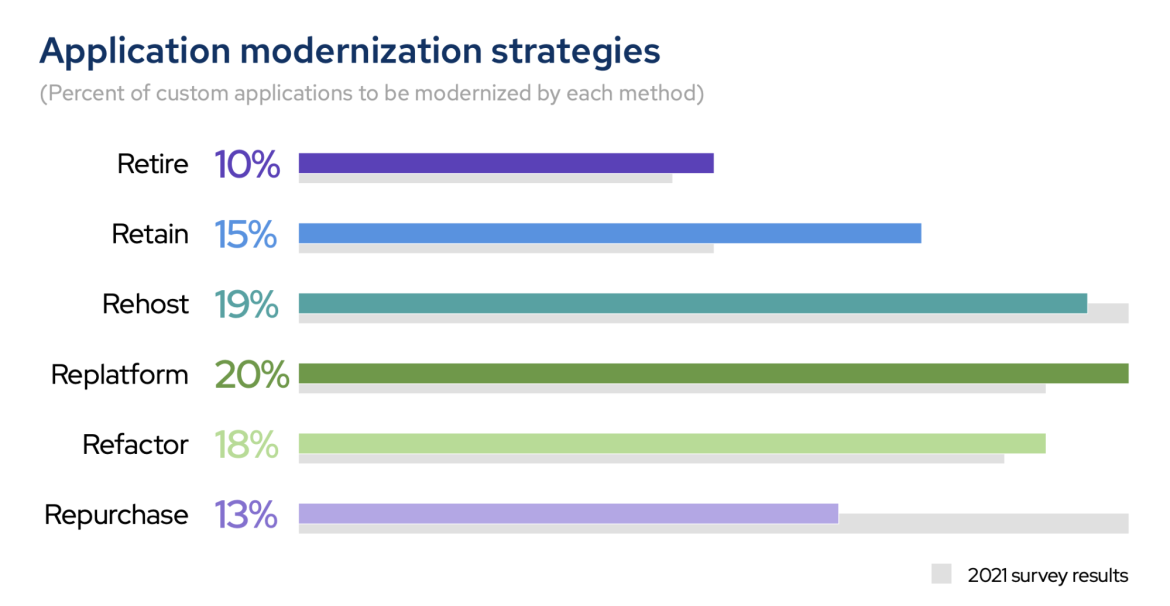Most organizations recognize that reinventing their IT systems and applications to meet both internal and external requirements needs to be an ongoing process. But how should they go about doing so? Konveyor community member Red Hat recently partnered with research firm Illuminas to see how organizations are going about their modernization process. The Konveyor community helps modernize applications by providing open source tools to rehost, replatform and refactor applications to Kubernetes and cloud-native technologies. Their diversity of tools provides the initial insight into this question. There’s no single approach.
The 6 Rs
When thinking about multiple ways to approach a task or problem, it’s often useful to have some sort of framework. For the purposes of modernizing applications mostly in the context of Kubernetes-based application development platforms, we followed the 6 Rs framework, a model deriving from the 5 Rs created by market researcher Gartner in 2010 at a time when many businesses were starting to grapple with how best to move their legacy applications to a cloud. (Sometimes you’ll also see a 7 Rs variant.) You’ll find some differences in nomenclature from different sources but the overall framework is widely used.
Here’s how we defined the framework for the 1,000 IT decision makers, software architects and developers we spoke with across the US, UK and English-speaking Asia-Pacific (APAC):
- Retire: Sunset or decommission applications that are no longer needed
- Retain: Leave critical applications as-is until refactoring is required
- Rehost: “Lift-and-shift” applications to a cloud (hosted or on-premise) without architectural changes
- Replatform: Optimize while migrating to the new platform to cloud-enable applications without changing core application code or architecture. (Sometimes referred to as “tweak, lift and shift.”)
- Refactor: Rearchitect as cloud-native, for example, by containerizing workloads or moving them to a serverless architecture
- Repurchase: Move from perpetual licenses to a Software-as-a-Service (SaaS) model
It’s not just retire or rewrite
If there’s a single lesson, it’s that there isn’t one.
When asked which approaches their organizations were taking for a given application, replatforming was the most common response at 20% and all the other responses were between 10% and 19%. Modernization strategies for custom applications are diverse and dependent on the applications being modernized, the sophistication of the organization, and even where the respondent sits in the organization.
Based on both these results and those from earlier surveys, the idea that IT organizations would set aside some applications and not touch them while going all-in on the latest hot technologies for greenfield tech is not the case.
Rather, IT organizations are addressing application modernization on a case-by-case basis.
It may be time to fully retire them because they’re no longer needed and it’s time to go in a different direction, but that was just 10% of the applications for respondents surveyed.

Other applications may mostly be technical debt. Needed for now—but you shouldn’t expend unnecessary effort on tweaking them except where security fixes and other near-term necessities aren’t really optional. (Consider these in the retain category, 15%.)
However, there are many other cases where some degree of overhaul is called for—and others for which rearchitecting is called for or even repurchasing as a SaaS application.
Where does refactor fit in?
Some of the respondents (15%) are planning to refactor applications to go straight to cloud-native using some of the approaches shown in the Red Hat architecture, Building Your Cloud-Native Applications.
This may not seem like a big number. But remember that this is in the context of modernizing applications. Although the survey didn’t specifically ask the question, it’s reasonable to assume that new applications are more likely to be architected as cloud-native from the outset.
Rearchitecting an existing application can be a significant commitment and it’s not surprising that most enterprises look to lower effort ways to modernize first.
We also learned something interesting about refactoring plans. The respondents that do plan to refactor are mostly not planning to jump directly there. 38% plan to rehost then replatform and only then refactor. (That number is even higher among organizations that describe themselves as continuously modernizing.) 47% plan to skip the rehosting step and just replatform, i.e., immediately make whatever cloud-enabling optimizations are needed, before refactoring.
The overall story is one of an incremental and deliberate approach to modernization.
Does SaaS play a role?
As we’ve found in other surveys such as this year’s 2024 Global Tech Trends, even as in-house application development remains important, it’s complemented by SaaS. And, indeed, 13% of the respondents in this year’s Application Modernization survey said that they intended to repurchase applications, which is to say move to a SaaS application.
This shouldn’t be taken as just replacing a customized in-house application with a cookie-cutter SaaS variant, however. A common thing that we see among customers is enhancing basic SaaS applications with partner products and also integrating them with enterprise data stores and other applications.
The Red Hat architecture, Integrating with SaaS Applications, takes a customer relationship management application as a study point and shows how, by integrating SaaS with other computing infrastructure, you can create a single, unified view of your data. This can make it easier to analyze data, make better decisions and automate tasks. The process typically involves API gateways including suites of products such as Red Hat Application Foundations.
Wrap up
We found an overall urgency to embark on application modernization efforts for reasons of reliability, security and scalability. We also found a significantly increased emphasis on applying this modernization to existing legacy infrastructure and applications as opposed to delivering new cloud services. This has been a common theme over the past year or so. New technologies (especially AI) are important, but what really matters is using those new technologies in support of your core business.
Learn more
Sull'autore
Gordon Haff is a technology evangelist and has been at Red Hat for more than 10 years. Prior to Red Hat, as an IT industry analyst, Gordon wrote hundreds of research notes, was frequently quoted in publications such as The New York Times on a wide range of IT topics, and advised clients on product and marketing strategies.
Altri risultati simili a questo
Ricerca per canale
Automazione
Novità sull'automazione IT di tecnologie, team e ambienti
Intelligenza artificiale
Aggiornamenti sulle piattaforme che consentono alle aziende di eseguire carichi di lavoro IA ovunque
Hybrid cloud open source
Scopri come affrontare il futuro in modo più agile grazie al cloud ibrido
Sicurezza
Le ultime novità sulle nostre soluzioni per ridurre i rischi nelle tecnologie e negli ambienti
Edge computing
Aggiornamenti sulle piattaforme che semplificano l'operatività edge
Infrastruttura
Le ultime novità sulla piattaforma Linux aziendale leader a livello mondiale
Applicazioni
Approfondimenti sulle nostre soluzioni alle sfide applicative più difficili
Serie originali
Raccontiamo le interessanti storie di leader e creatori di tecnologie pensate per le aziende
Prodotti
- Red Hat Enterprise Linux
- Red Hat OpenShift
- Red Hat Ansible Automation Platform
- Servizi cloud
- Scopri tutti i prodotti
Strumenti
- Formazione e certificazioni
- Il mio account
- Supporto clienti
- Risorse per sviluppatori
- Trova un partner
- Red Hat Ecosystem Catalog
- Calcola il valore delle soluzioni Red Hat
- Documentazione
Prova, acquista, vendi
Comunica
- Contatta l'ufficio vendite
- Contatta l'assistenza clienti
- Contatta un esperto della formazione
- Social media
Informazioni su Red Hat
Red Hat è leader mondiale nella fornitura di soluzioni open source per le aziende, tra cui Linux, Kubernetes, container e soluzioni cloud. Le nostre soluzioni open source, rese sicure per un uso aziendale, consentono di operare su più piattaforme e ambienti, dal datacenter centrale all'edge della rete.
Seleziona la tua lingua
Red Hat legal and privacy links
- Informazioni su Red Hat
- Opportunità di lavoro
- Eventi
- Sedi
- Contattaci
- Blog di Red Hat
- Diversità, equità e inclusione
- Cool Stuff Store
- Red Hat Summit

